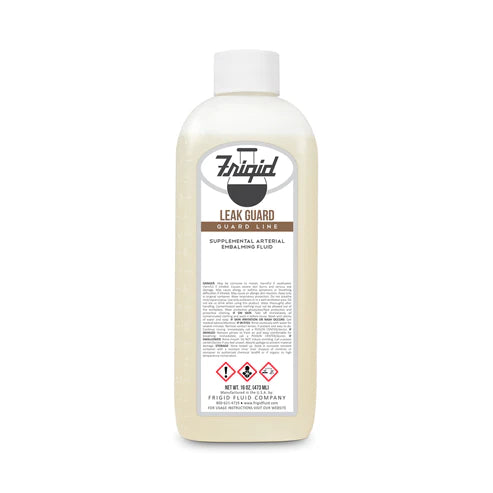Leak Guard Fluid
Leak Guard Fluid
SKU:LEAKG (Case of 12)
Couldn't load pickup availability
Features:
- Specifically designed to prevent leakage of body fluids and to pull excessive moisture from the body through the combination of an effective pore closer, a proven moisture reducer, a tissue hardener, and an effective firming agent for jaundice cases.
- To assist the preservation of the body, a powerful, non-formaldehyde disinfectant (glutaraldehyde) is included so that Leak Guard can be injected directly into tissue or used in conjunction with an arterial fluid.
- Especially applicable with badly bloated or water-logged bodies.
Embalmer's tips:
- The fluid is very effective. Only 8-10oz per gallon is needed for a normal sized body. If larger, one bottle is sufficient.
- Does not result in beading of fluid on the body like you can get from other chemical manufacturer's edema fluids.
16oz/473ml bottles
How to Use
How to Use
We recommend Leak Guard be used with the last gallon or two of diluted arterial fluid.
Depending upon the degree of leakage protection required, add 5 to 10 ounces of Leak Guard to each gallon of remaining diluted fluid. Be sure to mix thoroughly.
Special Circumstances:
Cases displaying Edema: For Low to Moderate Edema use 8-10 ounces per gallon as a co-injection in the last gallon or two of
diluted arterial solution using open drainage technique.
For Moderate to Severe Edema may require 12-16 ounces of Leak Guard per gallon of diluted
arterial solution.
Other Considerations:
For optimal disinfection 4 to 6 ounces of Water/Clot Guard could be added with the Leak Guard. Injection is best at a low pressure and modest flow rate using a pulsator. As each case will vary according to the condition of the body, the above recommendations can be altered as professional judgment dictates.
Additional Uses:
Leak Guard can also be used to enhance the firming action of cavity fluids and autopsy compounds. It is compatible with fluids containing less than 20% alcohols.
Leak Guard may also be used as an effective pore closer on skin donor cases at 8-10 ounces per gallon in the last gallon of diluted arterial solution using intermittent drainage technique.
SDS Sheet
SDS Sheet


